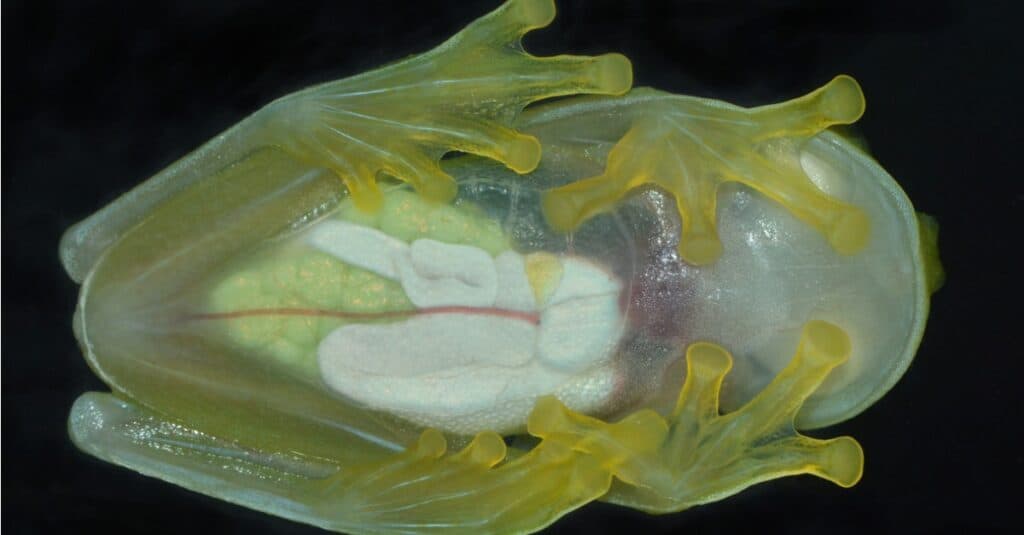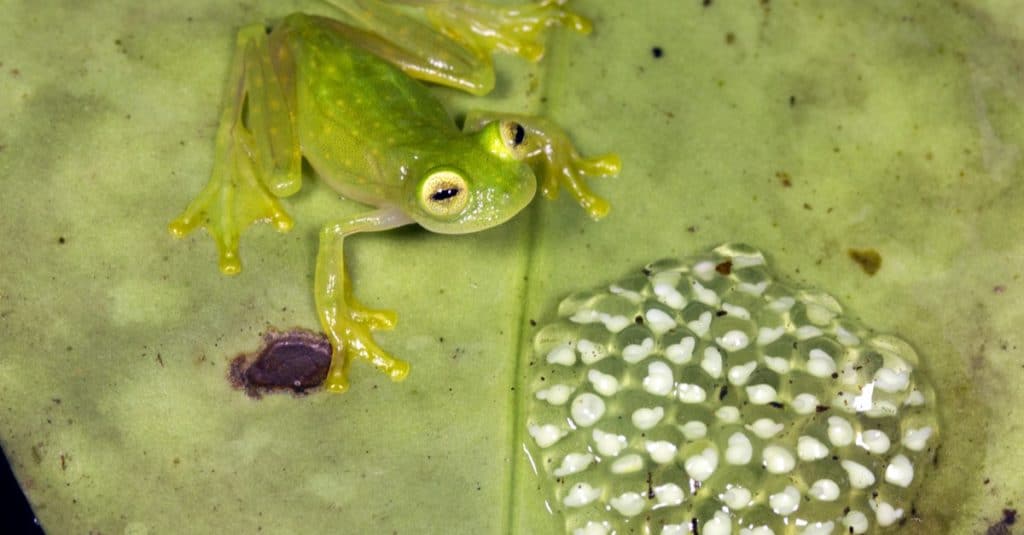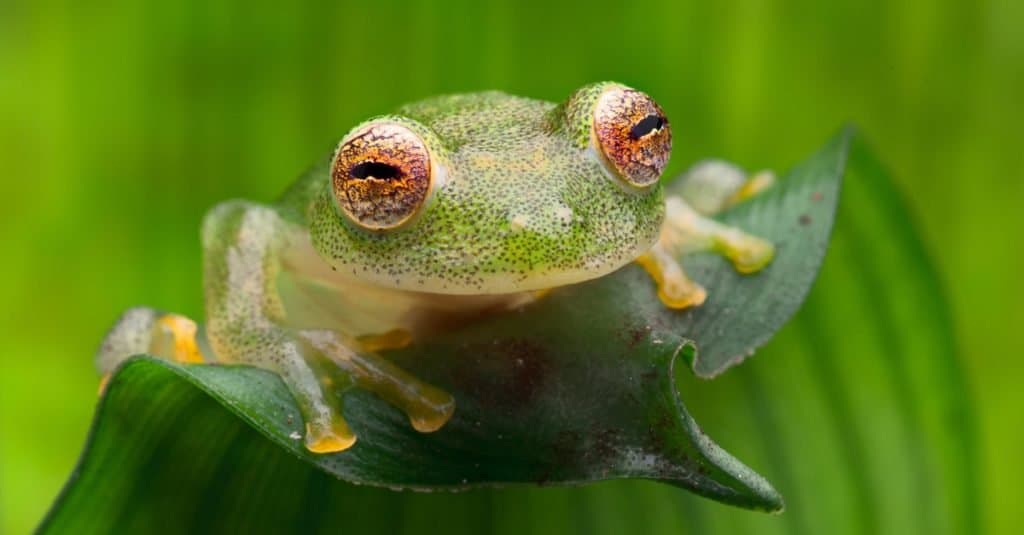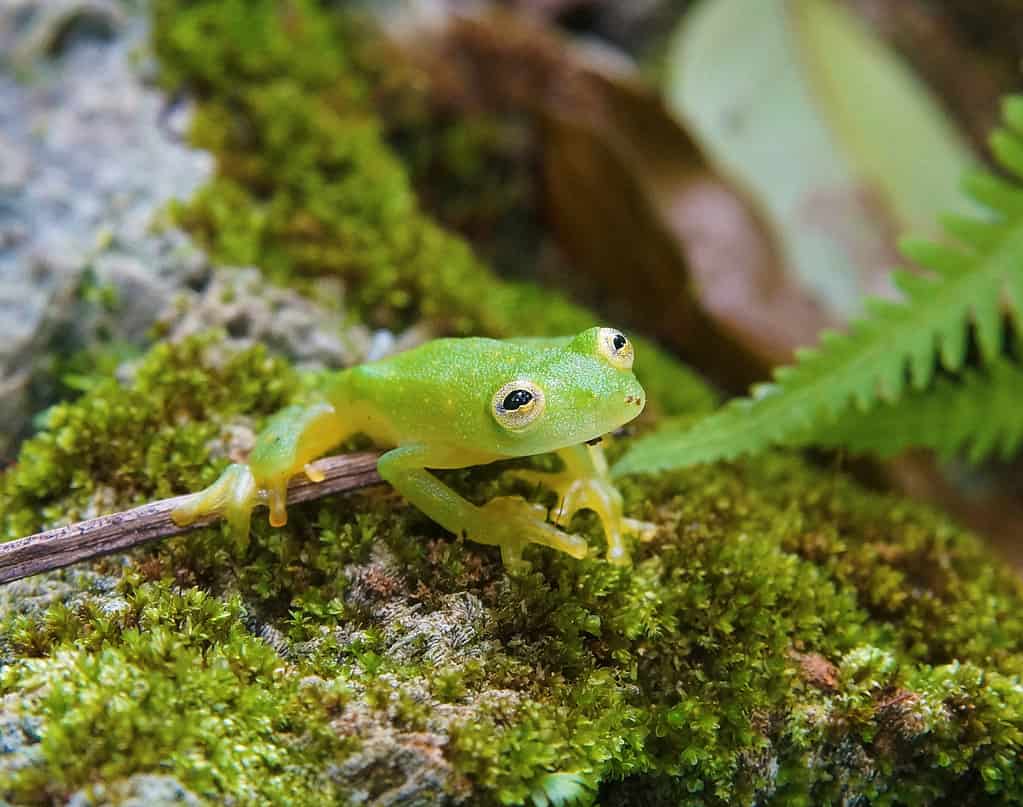Living high in the trees of South and Central America is one kind of frog unlike any other. And there’s not just one species of glass frog; there are actually more than 100 distinct species. Glass frogs are members of the Anura Order of frogs, which includes other carnivorous frogs.
Let’s learn about the 10 most incredible glass frog facts!
1. Glass Frogs Have Translucent Stomachs

The glass frog’s entire body is not see-through. Instead, the only translucent part is the abdominal wall.
©iStock.com/Maria Ogrzewalska
Glass frogs are so named for the glass-like appearance of their undersides. The skin on their bellies is completely translucent, which means you can see their stomachs, hearts, and other organs. In fact, you can actually see a glass frog’s heart beating, its intestines and stomach digesting food.
The purpose of the translucent underside is camouflage. The transparent parts of the frog actually break up its outline, which makes it much harder for birds to see them. So, glass frogs are actually better at hiding from predators than some of their less see-through cousins.
2. There are Around 160 Species of Glass Frog
Today, scientists know of about 160 species of glass frogs. Glass frogs are a type of tree frog native to the tropical forests of South and Central America. Glass frogs occur in 12 genera of frogs. However, most glass frogs belong to the Hyalinobatrachium, Cochranella, or Centrolene genera of frogs. But, glass frog scientific classification has by no means always been set in stone. In fact, scientists are still in disagreement over just how to classify something as either ‘glass frog’ or ‘not glass frog’.
3. Male Glass Frogs Stand Guard Over Their Eggs

Not all glass frog eggs get the chance to hatch because of predators.
©Dr Morley Read/Shutterstock.com
When the time comes to make baby frogs, males permeate the night with the sound of their bellowing calls. The older, or more dominant, a male is, the louder and more powerful his call. Females lay their eggs on the undersides of leaves or even branches above, or very close to, a source of running water. The male then fertilizes the eggs. But, his job isn’t done yet. In a behavior exceedingly rare for frogs, the male glass frog actually guards the eggs against threats—like predators and insects—until they’re ready to hatch. He also keeps them from drying out. On hatching, the brand new tadpoles fall to the ground and make their way to the water, where they will perhaps grow to adulthood.
4. Glass Frogs have Suction Cups on Their Toes
Despite their name, glass frogs aren’t entirely translucent. Their backs, legs, and toes do not have transparent skin. In fact, in one of the coolest glass frog facts, their toes have a different type of skin entirely. Glass frogs are tree-dwellers, and if they couldn’t grip onto the humid branches and leaves of their home, they wouldn’t last very long. That’s where their toes, which have tiny, yellow suction cups, come in. Their suction cup toes allow them to climb trees like they were born to it.
5. Glass Frogs are Nocturnal

Glass frogs are strictly nocturnal.
©Agami Photo Agency/Shutterstock.com
When you think of frogs, you probably think about croakers around a pond or wetlands. Chances are, you’ve heard frogs both during the day and at night. But, if you’re ever searching for glass frogs in the tropical rainforests of South and Central America, don’t even bother going out during the day. Glass frogs are strictly nocturnal and only come out at night. During the day, they rest up and get ready for the hunting, mating, and evasion of predators that the night will bring.
6. Glass Frogs are Arboreal
Another interesting glass frog fact is that they spend most of their lives in the trees. True, glass frogs don’t start in the trees. In fact, they actually start out life as tadpoles swimming around in running water, like small streams or on the forest floor. As soon as they grow legs and lose their tail, tadpoles move to the trees. There, they can use their transparent bellies to stay camouflaged from even the most keen of predators.
7. Glass Frogs Live in South America

Though frogs can be found on every continent but Antarctica, glass frogs occur only in South and Central America.
©Dirk Ercken/Shutterstock.com
Despite their worldwide fame, glass frogs only inhabit one continent in the world. Their distribution ranges from Panama to southern Mexico in Central America. In South America, glass frogs live in northern Argentina, southeastern Brazil, Venezuela, Tobago, and Bolivia. A few species occur in the Orinoco and Amazon River basins.
8. Glass Frogs are Carnivores
They might be small, but glass frogs actually spend most of their time hunting. That’s right, these tiny, adorable creatures are cold-blooded killers. Though humans don’t have anything to worry about. Glass frogs aren’t poisonous, and their tastes lean more towards spiders, flies, moths, crickets, insect eggs, and smaller frogs.
9. Glass Frogs Grow up to 3 Inches Long

Most glass frogs grow to around an inch long, though some don’t even get that big.
©Matt Jeppson/Shutterstock.com
Most glass frogs grow to around one inch long. But, one of the most interesting glass frog facts is that they have a huge range in size. The northern glass frog (Centrolenella fleischmanni) is one of the largest glass frogs. Adults measure nearly three inches long. Other species, like the reticulated glass frog (Hyalinobatrachium valerioi) grow to only about an inch long.
10. Male Glass Frogs Call to Potential Mates
During mating season, male glass frogs beg for the favors of females by calling to them. Females choose their mates based on the depth and resonance of their croaks. So, the more powerful a male glass frog’s call, the better chance he has of finding a mate. But, his job’s not done once he finds a receptive female. Since he cares for the eggs, his job is only just beginning.
The photo featured at the top of this post is © G.J. Verspui/Shutterstock.com
Thank you for reading! Have some feedback for us? Contact the AZ Animals editorial team.







